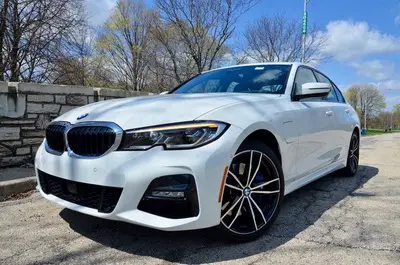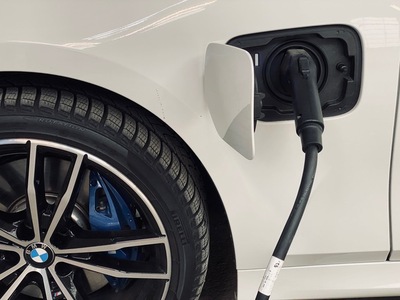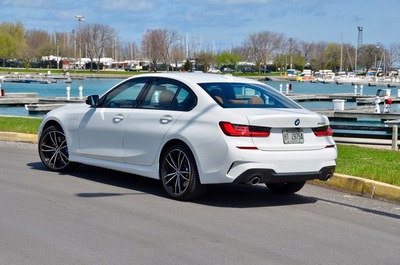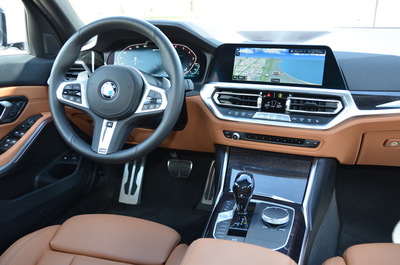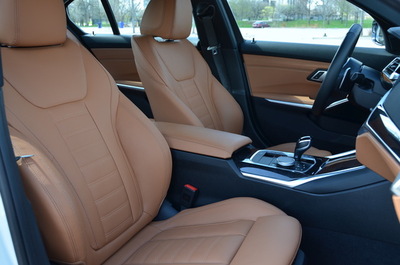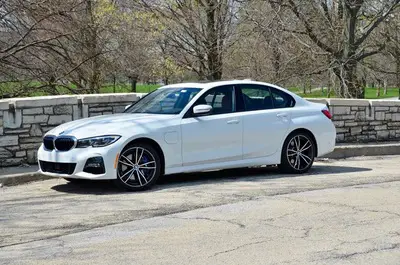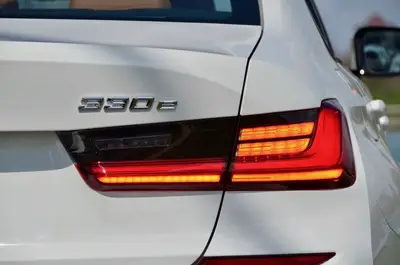2021 BMW 330e PHEV Sport Sedan - Review by Larry Nutson +VIDEO
A PHEV with Sport
By Larry Nutson
Executive Editor and Bureau Chief
Chicago Bureau
THE AUTO CHANNEL
I had just removed the plug for a Level 2, 240-volt EV charger from the front fender charging port and closed its access door on the 2021 BMW 330e when another car approached. The driver of the Smart EV lowered their window and said, “You know, that space is for charging electric cars.”
I smiled, said yes, and reopened the charging port door and pointed to the plug receptacle. With a sheepish grin the Smart EV driver responded nicely that they didn’t expect a big BMW sedan to be electric. I drove away silently.
The 330e plug-in hybrid (PHEV) is back for 2021 with some improvement. BMW calls it a performance plug-in-hybrid with the choice of either the 330e rear-wheel drive or the 330e xDrive all-wheel drive model.
Under the hood is a 181-hp 2.0-L turbo engine complemented by a 107-hp electric motor. The combined power output is 288-hp and 310 lb.-ft. or torque with XtraBoost. Power and torque gets to the wheels through an 8-speed automatic.
A high-voltage 34 Ah/12 kWh lithium-ion battery is located underneath the rear seats to provide the storage capacity for electric-only and performance driving.
The estimated EPA purely electric range for the 330e is 22 miles, or 20 miles for the 330e xDrive model. The estimated MPGe rating for the 330e is 75 MPGe or 67 MPGe for the 330e xDrive. The EPA rating for gasoline only operation is 28 combined city/highway mpg.
A brand-new feature in the 330e and 330e xDrive Sedans is XtraBoost. If you follow motorsports, it’s like the push-to-pass extra power mode in IndyCar. Available in SPORT mode, XtraBoost offers an immediate 40 hp power increase for up to 10 seconds.
The BMW 330e accelerates from zero to 60 mph in 5.6 seconds (5.7 seconds for the 330e xDrive). Top speed is limited to 130 mph with all-season tires. With summer performance tires, the 330e reaches a top speed of 142 mph (140 mph for the 330e xDrive model).
So! As you can tell, this electrified BMW has plenty of performance.
Around my Chicago home I drove the 330e in three different driving modes, on both local city streets as well as the highway. I used it as a typical hybrid driving around on a combination of gas and electric power. Overall the 330e delivers very comfortable and appropriately spirited performance in this mode.
Select SPORT mode and you are ready to go fast. Operating on the gas engine only, the 8-speed automatic has adaptive shift strategy that adjusts for the route and driving situation. Working with the navigation system and smart cruise control, the transmission uses data to avoid unnecessary gear changes when negotiating a series of fast corners or when approaching a vehicle ahead.
ELECTRIC mode is just that. Driving on battery power only. It’s emissions-free and fuel-free driving. Speed can be up to 87 mph. But the best use is in-city, slower speed driving doing your commute or taking care of household needs. The 22-mile range is actually very adequate for most city dwellers. I can do most all of my personal business within a 5-mile range of my home.
Plug-in hybrids provide the experience of driving a limited range on batteries, while offering the assurance of many hundreds of additional miles on hybrid or gas engine power. The all-electric range fits different needs and costs and is a great solution for clean air quality in city centers.
The 330e is very much a BMW with all the German design and engineering elements that makes a BMW the car it is. Ride, handling and negotiating corners are all done with ease and confidence. The optional Dynamic Handling Package provides variable sport steering and adaptive M suspension. Ride is a bit firmer with good steering response and feedback. The optional 40-series tires fitted on 19-inch wheel add a bit more road feel.
In the cabin, sport seats provide good comfort and support. The leather wrapped M steering wheel is very much to my liking with a nicely sized rim thickness. There’s a good complement of premium features and amenities. The instrument cluster displays various details about the electric drive. A tachometer appears in SPORT mode.
The hybrid battery takes up some space beneath the rear seat which results in the trunk and fuel tank being a bit smaller than the regular 3-series sedan. However, the 40/20/40 split rear seats enables more cargo space if need be.
The 330e I drove had a starting MSRP of $44,550. Options fitted to this car totaled $14,100 for a bottom line suggested retail price of $59,645 including the $995 destination charge.
information and specifications can be found at www.bmwusa.com. The new 3-Series PHEV models come standard with the Active Guard, Frontal Collision waring with City Collision Mitigation and Lane Departure Warning. BMW offers a full range of driver assist features in packages such as Drivers Assistance Pro, Parking Assistance and Back-up Assistance.
To take full advantage of the electric-only capability of the BMW PHEV they need to be kept charged. BMW has as dealer program to receive referrals to local service providers for the installation of a Level 2 BMW i Wallbox charging unit in a home. A professionally-installed 240v Level 2 home charging unit will charge up to 7 times faster than with a 120v standard outlet charger. Simply put, you need to plug-in every night.
Yes, the PHEVs cost $3300 more than traditional gasoline powered 330i sedans. However, they do qualify for a Federal tax credit of up to $5,836. There are also state and local incentives to consider.
Carmakers say hybrids, used properly with electric as the primary power source and combustion as a back-up, emit far less than conventional cars. They add that PHEVs are a popular transitional choice for consumers who want greener travel.
Happy motoring!
© 2021 Larry Nutson, the Chicago Car Guy



